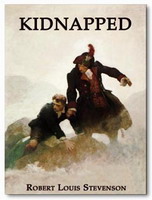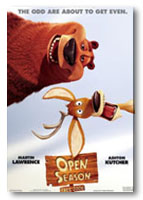Open Season on Beauty
- FREDERICA MATHEWES-GREEN
I didnt like the part in the restaurant, Hannah, my 6-year-old granddaughter, said. We were leaving a screening of Sonys new animated feature, Open Season, and I was trying to remember any scene in a restaurant.
 |
 |
When she said it was “too messy,” I realized that she meant an early scene where the movie’s lead characters, a suburban bear and a one-antlered deer, run loose in a mini-mart. After they rip open candy bars, gulp down slushies (bypassing the use of cups), and get a tongue tangled in the hot dog roller, the place is a sticky disaster.
I said, “I didn’t like the next part, when you see the bear through the window, and then he throws up on the window.” The memory of that fountain of candy-flecked green rose to mind. “Oh,” she said. “I didn’t know that was supposed to be throw-up.”
Grandparents have had all kinds of post-movie conversations with kids over the last seventy years or so, but this is probably the first time it’s included a lesson on identifying vomit.
After I took Hannah home, I just felt sad. This is a movie about talking animals, so it can’t be aimed at kids much older than she is. But there wasn’t any element I could honestly say was enjoyable — nothing that sparked wonder. There was lots of skittering and slamming and noise, and the screen often filled up with images that were just plain ugly.
For example, early on the deer wants the bear to promise to be his friend. So he hocks up something slimy and spits it into his hand, then holds it out, dripping, for a shake.
Not much later the deer and bear are lost in the forest, and the bear needs a toilet. He asks the deer, “Well, what do you do?” The deer says, “I don’t know,” and releases a stream of turds.
The deer (who walks on his hind legs) offers to carry the bear’s teddybear backpack. He straps it in front, over his crotch, where it waggles as he walks along.
Sure, potty-talk has always been funny to kids. But grownups didn’t teach it to them. They had something more significant to impart: stories to help children prepare for the world they were growing into. The best stories were complex and unafraid to deal with tragedy, like Hans Christian Anderson’s The Little Mermaid, or Carlo Collodi’s Pinocchio.
Earlier generations of parents complained that cartoon versions of such classic tales stripped them of all subtlety. The process has gone a step further in a movie like Open Season, where the plot presents only a starkly polarized pair of teams, good guys versus bad guys, and then whips up a frenzy of vengeance.
In fact older stories, like Kidnapped or The Count of Monte Cristo, used examples of unjust treatment to show a hero responding with mercy and renouncing revenge. Does it really prepare our children for a global culture when today’s stories instead celebrate self-righteous glee and violent revenge? |
There’s an innate human craving to identify an “other” whom you can hate with a full, free, undivided hatred. But till recently children’s entertainment did not feed that urge. In fact older stories, like Kidnapped or The Count of Monte Cristo, used examples of unjust treatment to show a hero responding with mercy and renouncing revenge. Does it really prepare our children for a global culture when today’s stories instead celebrate self-righteous glee and violent revenge?
I talked this over later with Hannah’s mom, and she brought up one of her own pet peeves: Bratz dolls. These are plastic gals who have huge cartoon-goldfish lips. They wear torso-hugging, midriff-baring clothes, enormous platform shoes, and a sly expression. They’re for girls 4 to 7 years old. When Hannah first saw them she said, “Why would anybody want a doll that’s ugly?”
Megan said, “There’s something creepy about the popularity of these dolls. Shouldn’t little girls want things that are beautiful? Why do they reject beauty and wholesomeness at such a young age?”
I inherited a picture book that had belonged to a great-great-great aunt, and inside the covers she’d drawn pictures of beautiful women. I guess girls have always done that, but in her case it was 1870, and the women are wearing ballgowns adorned with tiers of lace, with petticoats and pantaloons underneath. In the 1960’s, I drew women wearing a sheath dress and a mink stole, with hair in a Grace Kelly chignon. Do little girls now draw smirking women with exposed navels and heavy eye makeup? Has “edgy” become the new “beautiful”?
The usual retort is, “So just don’t watch these movies” or “Just don’t buy those dolls.” But you don’t have to buy this stuff; it leaks under the door. American entertainment culture has reached into every corner of the world, and if it’s not in your home, it’s in the home of the kid who sits next to yours in school. If you still don’t think snot is particularly funny, and don’t think it’s a good idea to luxuriate in revenge fantasies, you’re in the minority. This ugly, mean-spirited stuff is mingled with the very air we breathe.
So when I’m leaving the mall with Hannah I’m behind two middle-aged women who are laughing and loudly using the F-word. We pass a guy coming in wearing a t-shirt with an obscene message. Outside, there are obese teenage girls with too much pasty flesh spilling out of too-small clothes, trying to look haughty.
 This is J. Fraser Field, Founder of CERC. I hope you appreciated this piece. We curate these articles especially for believers like you.
This is J. Fraser Field, Founder of CERC. I hope you appreciated this piece. We curate these articles especially for believers like you.
Please show your appreciation by making a $3 donation. CERC is entirely reader supported.

Acknowledgement
Frederica Mathewes-Green. "Open Season on Beauty." Dallas Morning News (October 1, 2006).
Reprinted with permission from Frederica Mathewes-Green.
The Author
Frederica Mathewes-Green is a wide-ranging author. She has published 9 books, including Facing East: A Pilgrim's Journey into the Mysteries of Orthodoxy, The Illumined Heart: The Ancient Christian Path of Transformation, At the Corner of East and Now, The Illumined Heart, The Open Door: Entering the Sanctuary of Icons and Prayer, and Gender: Men, Women, Sex, and Feminism. In the past, her commentaries have been heard on National Public Radio's All Things Considered and Morning Edition. Her essays were selected for Best Christian Writing in 2000, 2002, 2004, and 2006, and Best Spiritual Writing in 1998 and 2007. She has published over 700 articles. She lives in Linthicum, Maryland, with her husband Fr. Gregory, pastor of Holy Cross Orthodox Church. They have three children and three grandchildren.
Copyright © 2006 Frederica Mathewes-Green

